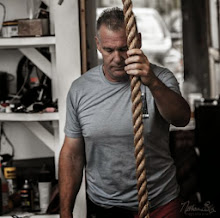My dog, the star of my canine mfr video "Jake", has come up with a new game. He goes into our backyard. This causes the rabbits to run under the deck to get away from him. This in turn keeps Jake on the deck looking and smelling through the spacing in the decking to "chase" the rabbits. He runs from one place to another, chasing after the rabbits, as they move to avoid his scrutiny. If one of the rabbits decides that the best solution to the dog is to stay still he scratches at the deck to get them to move. It frustrates the you know what out of him but he loves it. Or should I say he's addicted to it. It's really not much different to my addiction to TV or the internet.
As I'm writing this Jake and me are outside on the deck. He's taking a break from the rabbits. Perhaps he got bored with his cure for his boredom, who knows why he's on break?
It has me contemplating how much of my time is spent in my habitual pattern. This is something we talk about in Meditation as well as Rolfing. How we become habituated to our simple activities, the easy ones, or easy way of doing things. I have taken this a little bit further to suggest that this is how we survive. Through the a minimum expenditure of energy to accomplish a task. If we habituate something than it becomes "natural" and easy. From the Rolfing body view we can say that this habituation originates in an avoidance of a restriction, which makes it easier to follow a certain movement path. In meditation we could say that each action plants a karmic seed which will come to fruition later when the same conditions arise. In other words if Jake scratches on the deck to get at the rabbits and I get mad at him this plants a seed of being mad. The next time he scratches--the condition--that karmic seed of mad can come to fruition. If through meditation I become familiar with my mind and its speed I can make a break the habit and decide if I want to get mad or ? That plants the seed of decision which eventually may over plant the seeds of mad. Complicated eh?
Back to the body's habitual patterns. My premise is that a body will not, should not change what we consider a habitual pattern if that pattern is energetically efficient, unless we propose to it one that is more efficient. We can experience this on the micro level as a guide to our work at a more macro level. We all approach our work with hoping to see a change in our client's structure, movement, etc.. This is the macro. We all have to try and translate this macro strategy into a series of smaller micro interventions that will hopefully accumulate into the resulting macro change. Unfortunately we sometimes get hooked into a habitual pattern while working with our client that is not supporting the micro.
What I am saying is that every micro intervention has to be accepted as an energy efficient change by the body to be accepted. If not than we risk depleting the client's available adaptive capacity and not getting the results we hoped for.
My suggestion to people who train with me is to make small interventions. If these are accepted--as evidenced by local tissue change--than continue with that. If they are not accepted stop and reconsider the local intervention in favor or a different one that is accepted.
This is contrary to what happens in most massage settings or anything that promotes a routine--read habituated pattern--that does not allow for local evaluation of efficacy. This is a sacrifice of the local in hopes of a larger global change--usually one where the client becomes "spaced" out. I'm advocating for local change in support of a more global one. With this strategy we are working with the body and allowing it to direct its own change, one that benefits it more energetically.
Any thoughts?
Thursday, June 18, 2009
Subscribe to:
Post Comments (Atom)




No comments:
Post a Comment